You didn’t start your firm just to stay afloat — you started it to build something bigger. Something that brings in the right clients, delivers real impact, and grows without burning you out. But for that to happen, skill alone isn’t enough. Law firm growth doesn’t happen by chance — it takes strategy and structure.
Many great lawyers stay stuck not because they lack talent, but because they’re buried in the daily grind—handling intake, chasing leads, and managing chaos. Meanwhile, firms with strong systems continue to grow, even if they’re less experienced. That’s the difference structure makes.
This guide is here to help you shift gears—from reacting to everything to leading with intention. You’ll learn how to build a law firm that runs efficiently, attracts better cases, and scales with confidence.
- SEO makes your website visible to potential clients.
- If you don’t know your acquisition cost, every choice is a risk.
- Broad positioning misses clients seeking specific expertise.
- Firms with better systems will keep outranking you — skill alone isn’t enough.
- Automating intake, scheduling, and documents saves time for real results.
- Delegation works only when roles are clear and outcomes are tracked.
- Marketing without tracking isn’t strategy — it’s guesswork.
Main Barriers to Law Firm Growth
It’s not that you’re doing anything wrong — it’s that a few silent issues are slowing everything down. Clients don’t return. Your marketing feels invisible. Financial decisions are more instinct than insight. These problems creep in quietly and compound over time.
This section unpacks the hidden friction points that keep law firms from scaling, so you can spot them early and fix them before they cost you more time, clients, and growth.
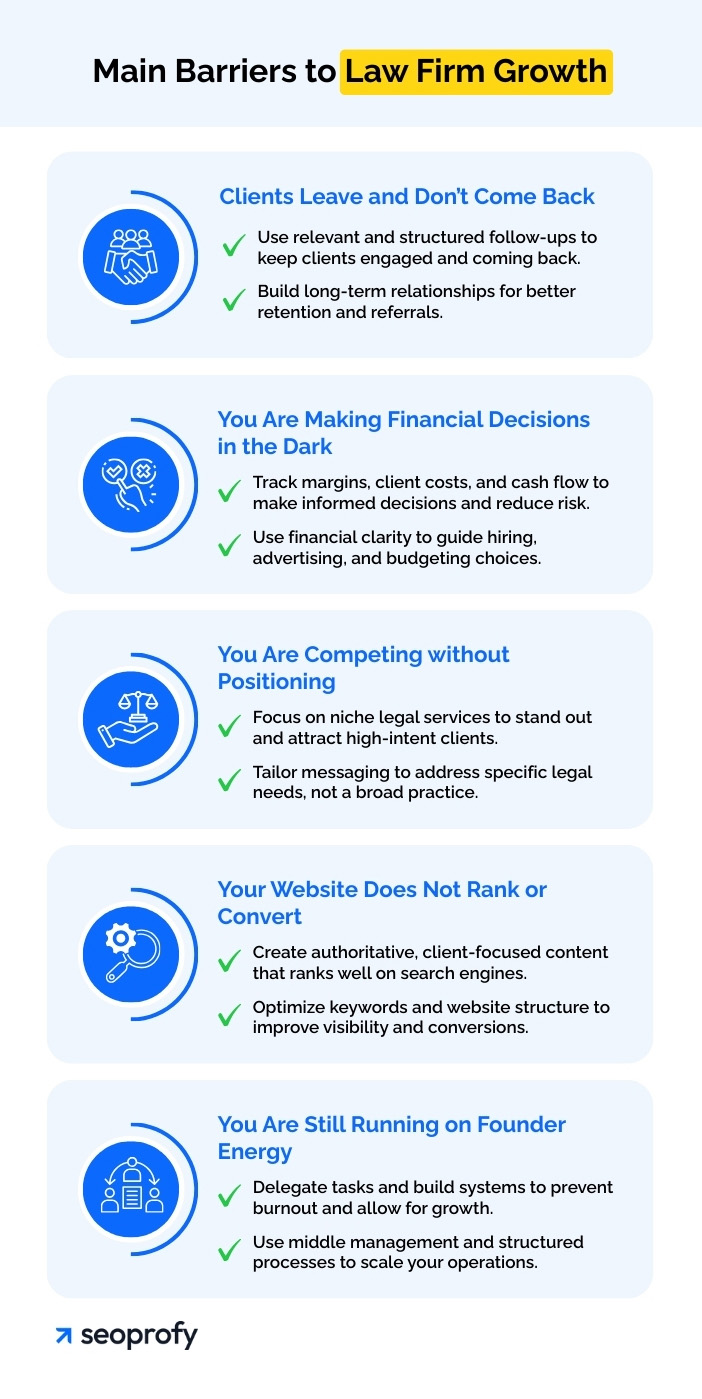
Clients Leave and Don’t Come Back
Most firms still treat legal practice as a one-time service. A client hires you, gets a result, and disappears. The firm moves on. But this churn breaks sustainable growth. A lack of structured follow-up, whether through newsletters, case updates, or post-engagement check-ins, means no reactivation, no referrals, no compounding visibility. Growth depends on not wasting the clients you already have.
You Are Making Financial Decisions in the Dark
You don’t need to be a CFO to run a successful firm — but you do need basic financial clarity. Without a clear view of your margins, client acquisition costs, or cash flow, every decision becomes a risk. Whether you’re hiring staff, launching ads, or outsourcing SEO, guessing what you can afford — or what will pay off — leads to wasted time and money. Growth depends on knowing what each new client brings in, what it costs to land them, and how sustainable your operations really are.
You Are Competing without Positioning
Many firms present themselves as full-service or general practice — and that can work well when referrals fuel most of the business. But in digital marketing for lawyers, the rules are different. Once you start reaching beyond your immediate network, broad positioning becomes a liability.
People don’t search for general help. They look for answers to very specific legal issues — like contesting a will, negotiating a non-compete, or filing a personal injury claim. If your messaging is too broad, potential clients may never realize you’re exactly who they need.
Your Website Does Not Rank or Convert
For many firms, the website looks fine on the surface. It has service pages, a contact form, maybe even a blog. But it does not bring in leads. Traffic is low, and the few visitors who do arrive rarely reach out. Here is where things usually fall apart:
- The content fails to demonstrate real experience or authority and doesn’t address the specific questions your potential clients are asking. Search engines prioritize content built on the E-E-A-T concept, and your competitors are winning visibility by publishing content that meets those standards.
- Additionally, ineffective keyword targeting can cause your site to rank for irrelevant searches — or fail to appear for high-intent queries that matter to your practice.
- The structure follows internal logic instead of client needs. People cannot tell what you do, how to contact you, or whether you are even taking new clients.
- The work was done in-house with no law firm growth strategy behind it.
SEO for lawyers isn’t just about keywords — it requires technical precision, strategic content, and consistent execution. Building an in-house team is often costly and impractical, especially for smaller or scaling operations. That’s why many legal professionals rely on specialized agencies that understand how to get real results in their niche. In fact, over 80% outsource their SEO — because effective growth depends on proven expertise, not trial and error.
You Are Still Running on Founder Energy
In the early stage, the founder holds everything: sales, legal marketing strategy, client relationships. As the firm grows, this creates bottlenecks. Without systems, delegation, and middle management, the firm hits capacity fast. The result is burnout at the top, underperformance below, and zero space to scale your law practice.
“You’re Not Losing to Better Lawyers. You’re Losing to Better Systems.”
Proven Growth Strategies for Law Firms
Law firm growth is not a single decision. It is a set of actions that stack up over time. Some firms need more visibility. Others need better intake. Most need a clearer message and fewer wasted steps. This section brings together practical strategies that work across different stages. Use them to strengthen your law practice and build a competitive advantage with fewer dead ends and experiments.
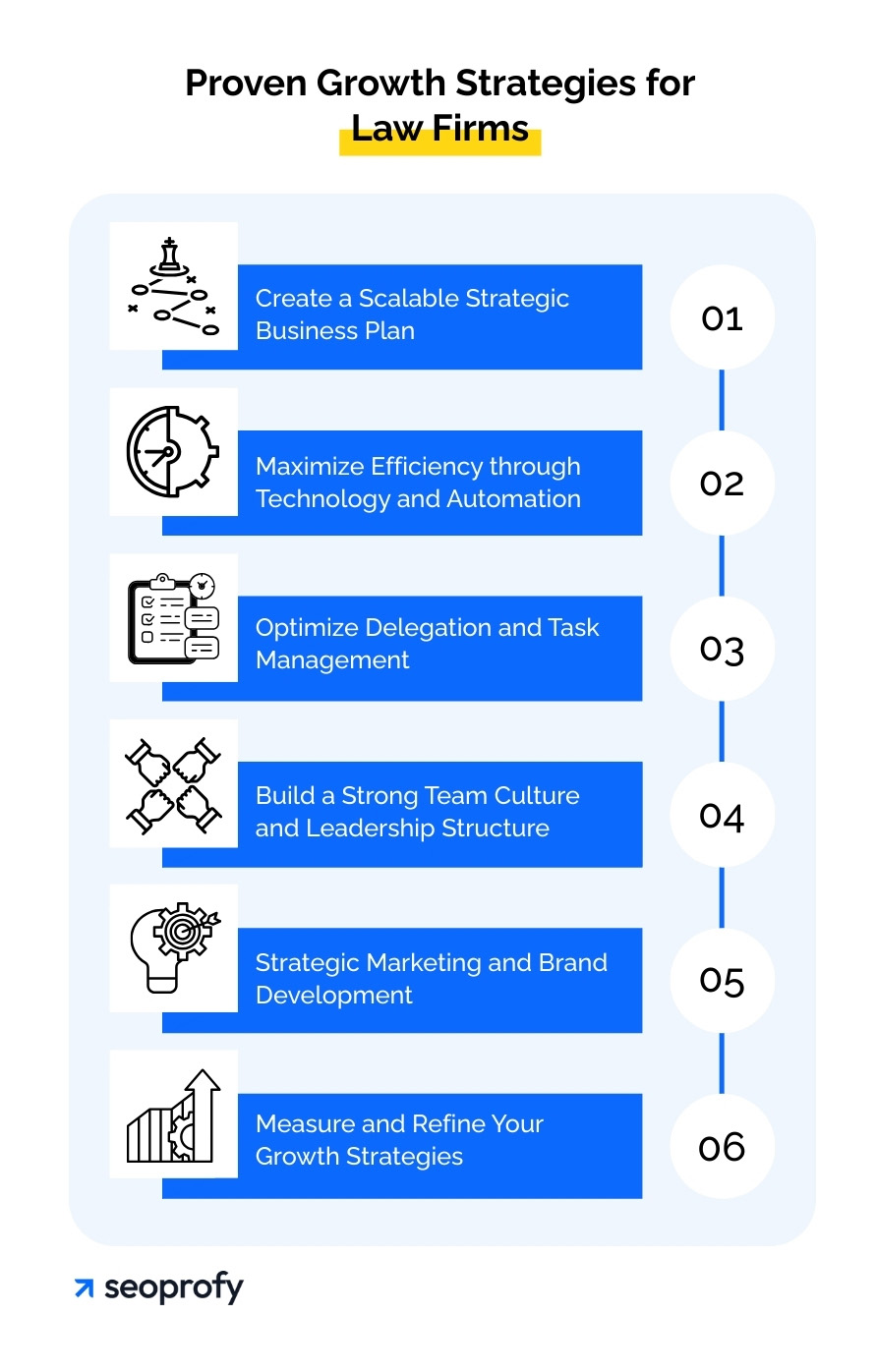
1. Create a Scalable Strategic Business Plan
Strategic planning gives your law firm a clear growth path. It defines where you want to go, how you will get there, and what resources you need. Without it, decisions stay reactive and results stay inconsistent.
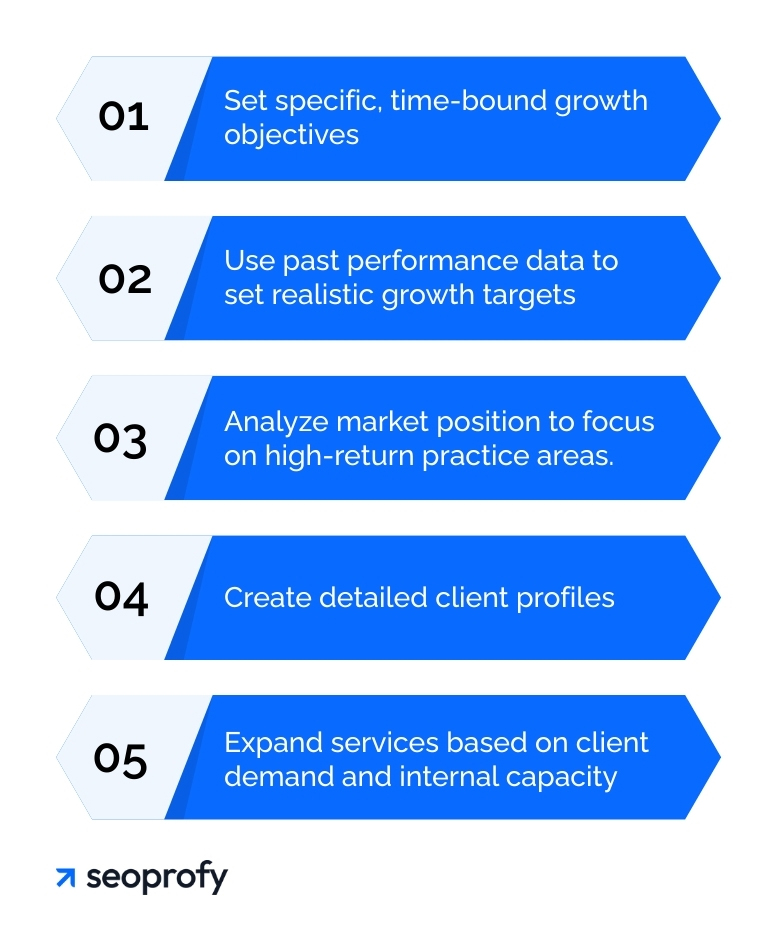
Start by defining law firm growth objectives. These should be specific, time-bound, and tied to outcomes. Instead of vague business goals like “grow the practice,” try:
- Increase revenue from corporate customers by 20 percent in 12 months
- Open a second office focused on estate law next fiscal year
- Double the number of retained family law clients in the next quarter
Use past performance data to set realistic targets. Track conversion rates, client value, and average case cycle time to understand your current baseline.
Next, analyze your market position. Review your current caseload to identify which practice areas bring the highest return. Look at where your best clients come from and what kinds of matters you handle most efficiently. Study your top competitors manually — what services do they emphasize, how do they describe their value, and who are they clearly targeting. You do not need advanced tools here. Use what is already in front of you.
Then, build detailed client profiles. Use intake data, CRM exports, and past case records to find common patterns:
- Client type
- Urgency level
- Average case size
- Typical objections.
Segment by value and retention potential. One way to do this is by combining two metrics: average revenue per client and average lifetime engagement. This helps you prioritize high-value relationships and focus on nurturing relationships that are most likely to lead to repeat business or referrals.
Finally, outline service expansion based on actual demand. Before launching anything new, check your intake logs. Ask your staff what clients often request that you currently do not offer. Test new offers through landing pages or small pilot campaigns before committing budget. Align each new service with internal capacity and expected margin.
This plan does not need to be long. It needs to be usable. When done right, it lets you grow with intention, not guesswork.
2. Maximize Efficiency through Technology and Automation
Scaling a law firm without scaling chaos requires automation. Technology reduces time spent on repeatable tasks, lowers error rates, and frees up staff for higher-value work. Efficiency comes from systems that work together, not from having more software.
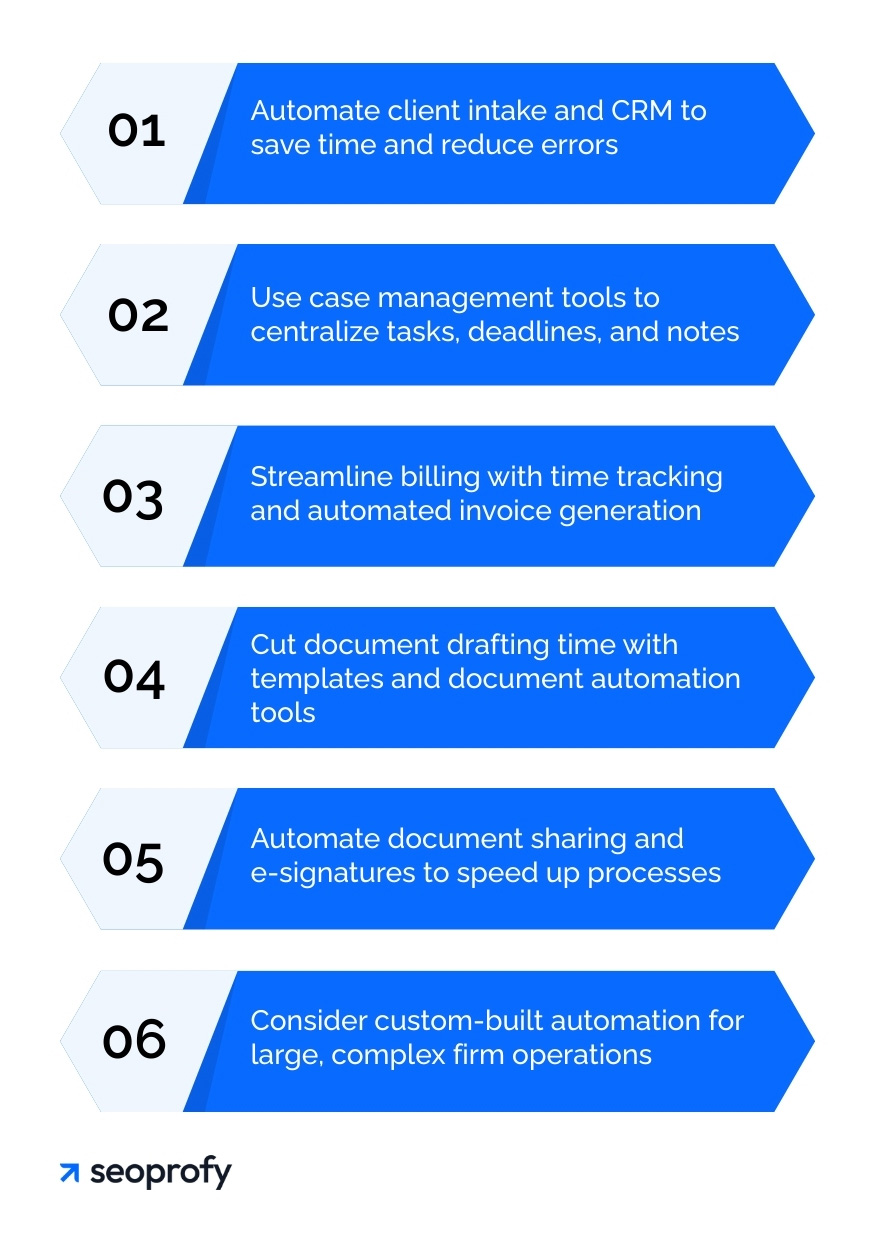
Start with client intake and CRM. Systems like Clio Grow, Lawmatics, or HubSpot help standardize how new leads are collected, qualified, and followed up. When someone fills out an intake form, their information flows directly into your CRM, so your team doesn’t have to enter it manually. You can set up automatic reminders for consultations, status updates, and follow-up emails based on user actions.
Move next to case and task management. Tools like Clio Manage, PracticePanther, or MyCase allow teams to assign tasks, set deadlines, attach notes, and share documents in one place. These platforms give you a clear dashboard so you don’t have to dig through messy spreadsheets or scroll endless email chains.
For time tracking and billing, platforms like TimeSolv, Bill4Time, and Rocket Matter streamline the entire process. Attorneys can:
- Track billable hours with a single click, including from mobile devices
- Generate invoices automatically based on recorded time
- Review and edit pre-bills before sending
- Set automated reminders for overdue payments.
Use document automation to cut drafting time. Tools like LawYaw, Woodpecker, or Gavel, previously known as Documate, let you build templates for contracts, agreements, or court filings. Staff can generate fully formatted documents by entering case-specific details once. Besides saving hours, it also ensures consistency across documents.
Secure document sharing and e-signatures are other areas worth automating when growing a law firm. Platforms like NetDocuments, Dropbox for Business, or Box offer version control and access logs. Combine them with tools like HelloSign or DocuSign to speed up signing and cut mailing delays.
If your firm is planning a significant expansion and expects to run a large operation with multiple departments and high case volume, off-the-shelf tools may start to stack up. For firms with complex workflows and long-term plans, investing in custom-built automation may be more practical. While the upfront cost is higher, internal systems can reduce long-term operating costs.
3. Optimize Delegation and Task Management
Delegation in a law firm means redistributing operational, procedural, and support tasks across three layers: attorneys, staff, and external vendors. The goal is to keep attorney work at the center. It starts with separating what requires legal judgment from what does not. That includes identifying which tasks demand a licensed attorney, which can be handled by trained paralegals, and which should be outsourced without risking quality or compliance.
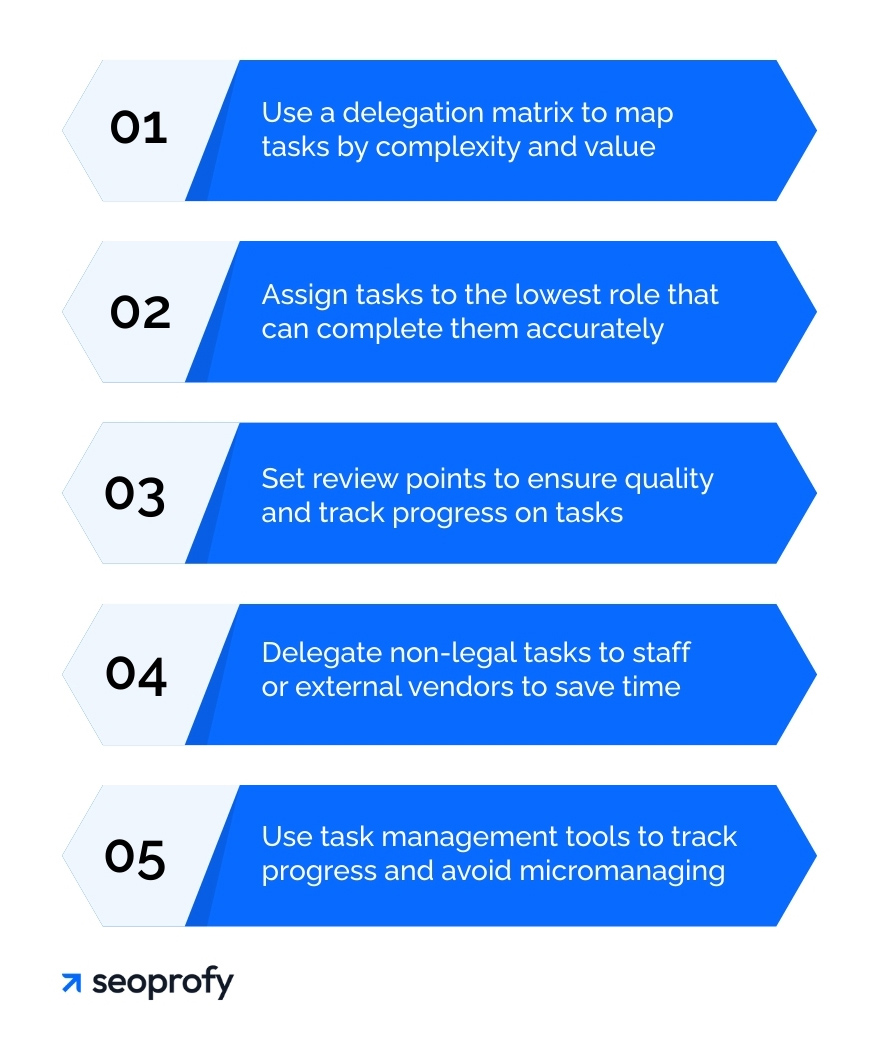
Start by creating a delegation matrix. Map out everything that happens in the firm, from initial intake to trial preparation to marketing. For each task, define its complexity, risk level, and value per hour. This makes it easier to decide whether it belongs with a partner, an associate, a paralegal, or a third-party service provider. Here is one way to build and manage an effective delegation system:
- List all recurring and project-based tasks
- Categorize them by legal complexity and urgency
- Assign each to the lowest role that can complete it accurately
- Document what “done well” looks like for that task
- Set review points along the way to ensure quality
For example, case research may shift from attorneys to trained paralegals using defined templates. Administrative follow-ups can go to the support staff. And specialized work outside your team’s core, such as link building or implementing local SEO for a law firm, can be handed off to experienced agencies with clear performance criteria.
Delegation also relies on visibility. As a law firm owner, use task management tools to keep track of who’s doing what, when it’s due, and what’s still in progress. Weekly reviews should surface blocked tasks, misalignments, and unclear ownership. It keeps things moving without adding more meetings, check-ins, or micromanagement.
4. Build a Strong Team Culture and Leadership Structure
Law firm growth is not driven by tools alone. It relies on the way your team works day to day. Who you hire, how roles are defined, and how decisions are made all affect how well the firm functions as it expands. Firms that scale smoothly build structure around people, not just processes.
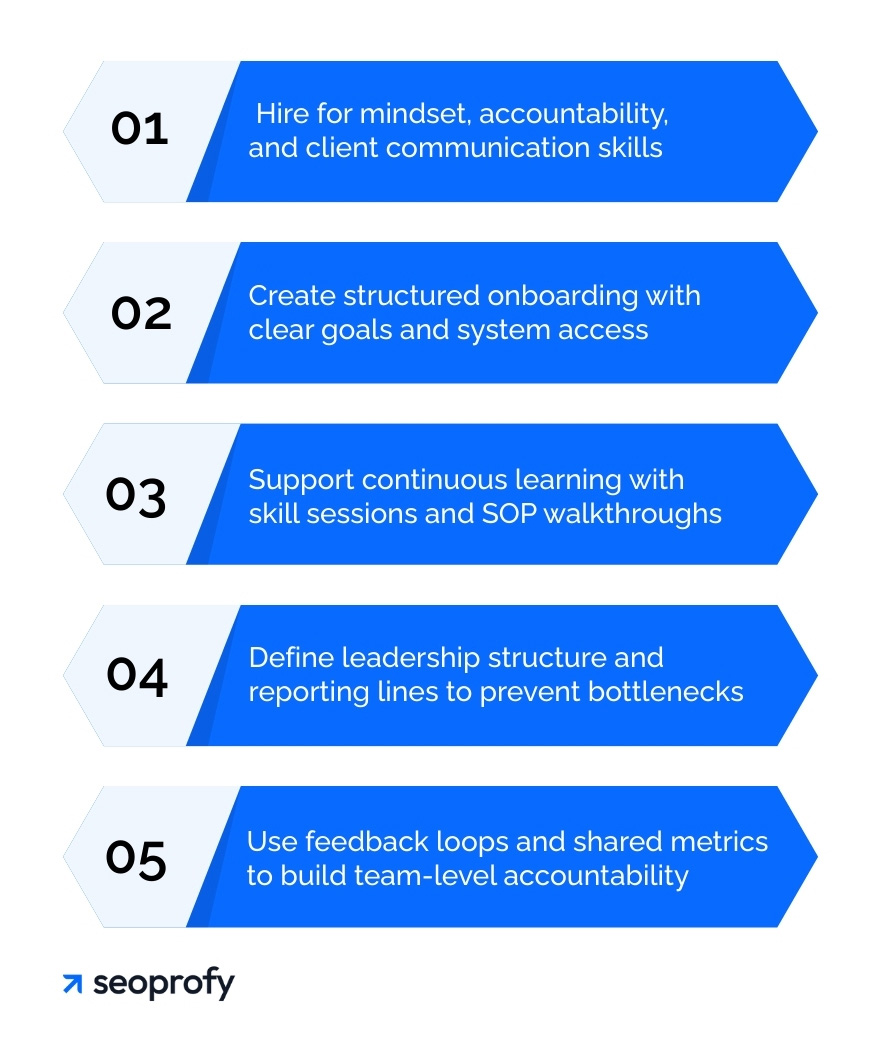
Start with hiring. Define not just the role but the type of person who thrives in your environment. That means writing job descriptions based on behaviors and expectations, not just qualifications. During interviews, ask situational questions that test for mindset, accountability, and client communication skills, not just experience with certain case types.
Once people are hired, onboarding becomes critical. This is especially true when someone joins a practice with a specific legal focus or enters a highly procedural area. Unstructured onboarding leads to knowledge gaps and inconsistency in client outcomes — especially in procedural-heavy practices. Build a structured onboarding process with clear checkpoints:
- Access to systems and tools
- Shadowing key casework and observing real client interactions
- Clear communication protocols and team expectations
- Defined goals for the first 30, 60, and 90 days
Build systems that support learning in small, consistent blocks. This can include short weekly skill sessions, recorded SOP walkthroughs, ethics refreshers, and updates on jurisdiction-specific procedures. Focus on making knowledge accessible and repeatable, especially as rules and expectations shift across legal contexts.
Leadership must be structured. A flat organization has five people. It breaks at fifteen. Define reporting lines, decision-making authority, and escalation paths early. If one partner holds all control, the firm’s growth will bottleneck at their calendar.
Create regular feedback loops. That includes performance reviews, 1:1 check-ins, and team retrospectives. Use shared metrics (matter progression benchmarks, response times to client inquiries, and turnaround times on filings) to create team-level accountability.
Culture is not perks or slogans. It is what people do when no one is watching. When your team knows what is expected and has the tools to meet it, growth becomes consistent.
5. Strategic Marketing and Brand Development
A strong marketing plan allows small law firms to attract potential clients, build authority, and grow on purpose, not just by referral luck. Most firms that grow consistently have one thing in common — they’ve figured out how to handle branding, SEO and content, paid channels, and platform presence the right way.
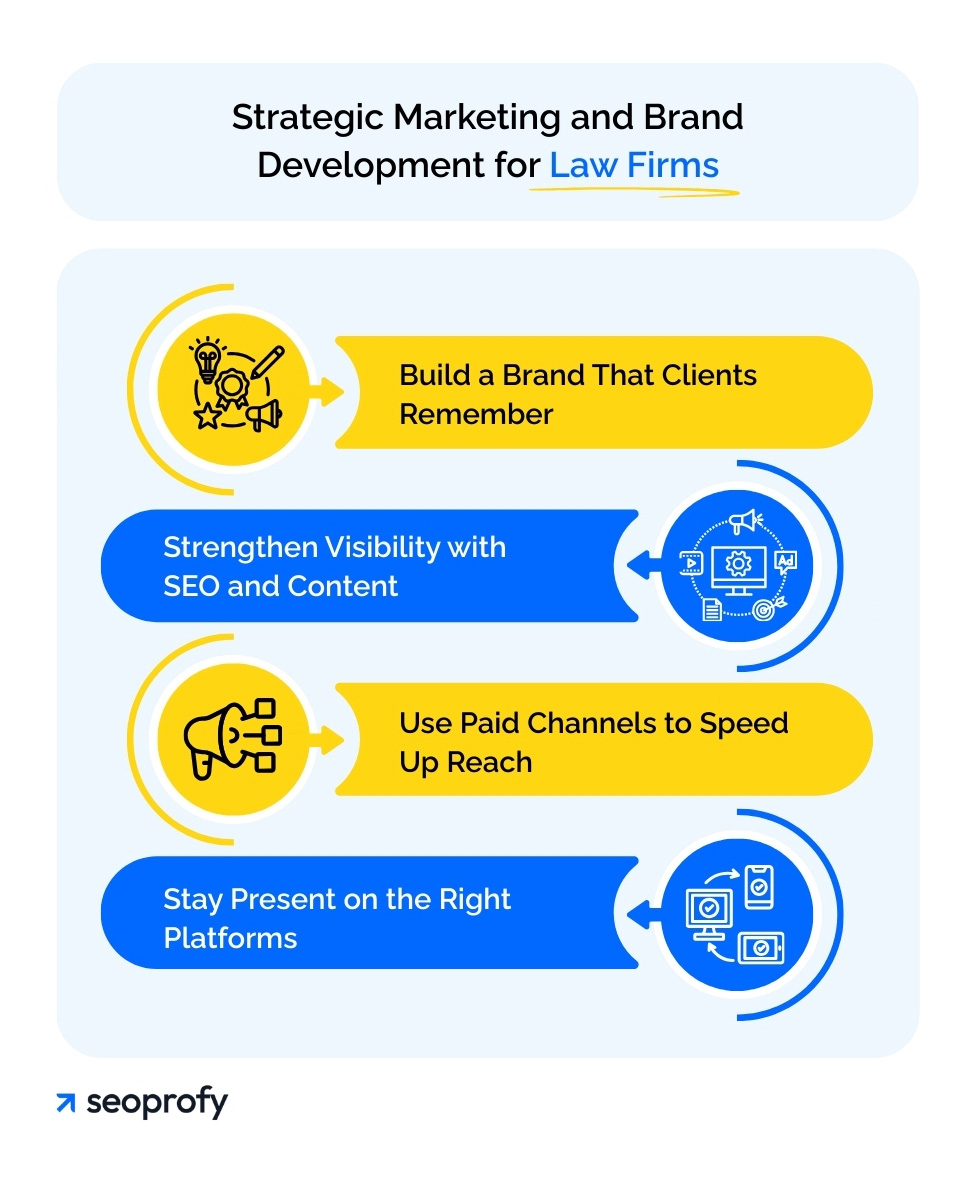
Build a Brand That Clients Remember
Branding is what makes your firm recognizable, trustworthy, and memorable. Without it, your message blends into every other firm claiming to deliver “results” and “client-first service.” Here’s what to focus on when building a legal brand that stands out:
- Define your unique value proposition. Show what you do better than others and make it visible in your headlines, bios, and service pages.
- Set a clear brand voice. Decide how you speak about pricing, risk, and results, and keep that tone consistent across all channels.
- Build a visual identity. Use clear rules for logo use, colors, fonts, and imagery across your site, documents, and presentations.
- Align your team. Everyone should represent the same brand tone and values in every client interaction, from emails to meetings.
There’s no single blueprint for effective legal branding. These two firms prove that even within the same field, contrast can work if the growth strategy for a law firm is clear.
Willkie Farr & Gallagher presents itself as a modern, globally minded firm. Their clean design, muted colors, and focus on innovation and “A-List” recognition position them as forward-thinking and high-performing.

Simpson Thacher & Bartlett takes the opposite approach. Their branding leans into tradition and authority, with a classic layout and messaging built around deep expertise in corporate law and private equity.

Strengthen Visibility with SEO and Content
Search remains the primary channel for clients seeking legal help. If your firm isn’t visible for relevant queries, those leads go to competitors.
To understand which queries to rank for, start with keyword research. Tools like Ahrefs and Semrush show what potential clients actually search, how often they search it, and how hard it is to rank. For example, “criminal defense lawyer” has strong intent and high traffic potential, but also very high keyword difficulty. It is valuable, but hard to win.

Instead of focusing only on highly competitive terms, explore keywords with lower difficulty that still match strong intent. Open the “Matching Terms” report in these tools to discover variations that might be easier to target. For instance, “criminal lawyer for DUI first offense” might have lower competition and still be highly effective for getting clients as a lawyer.
A strong SEO strategy usually blends these types of keywords. Some pages can target broad, high-volume terms to build authority over time. Others should go after more specific long-tail queries that bring conversions faster. Your content strategy should reflect this balance and map keywords to relevant location and practice area pages and blog posts based on their intent.
Local SEO deserves its own focus. Google Business Profile is your main tool here. Keep your NAP consistent across directories, add detailed service descriptions, and update photos regularly. To rank in the map pack, you also need positive reviews and localized landing pages that include your practice areas and city-specific phrases.
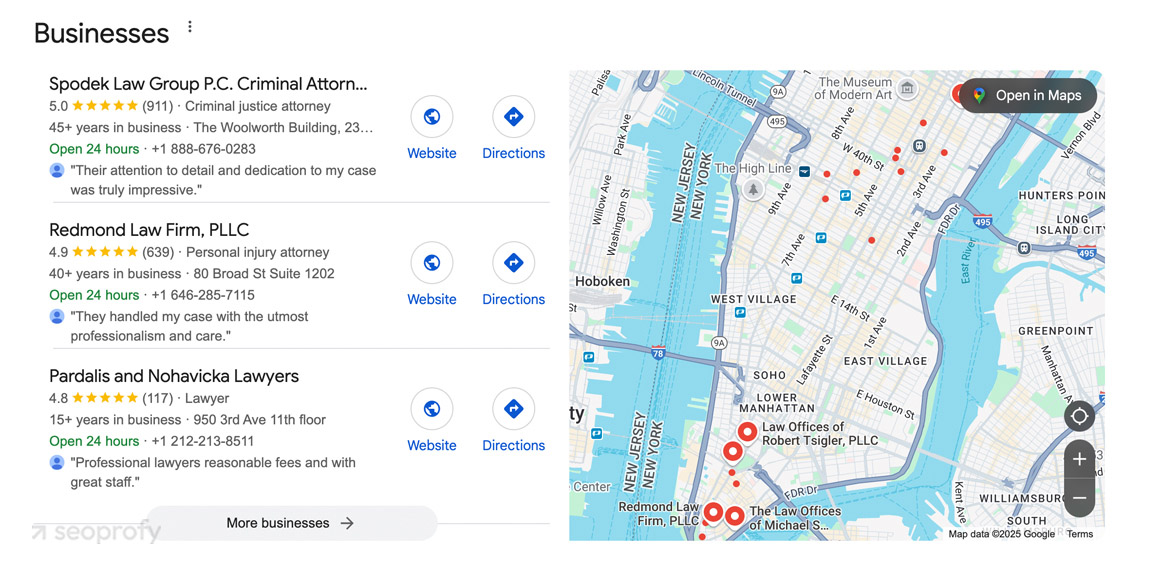
One of the most important off-page strategies is link building for lawyers, which should focus on high-authority placements like bar associations, law school websites, legal directories, and niche blogs. These links carry more trust and impact than general directories.
Technical SEO supports everything else. Make sure your site is fast, mobile-friendly, and crawlable. Run audits with SEO tools like Screaming Frog or PageSpeed Insights to catch errors early.
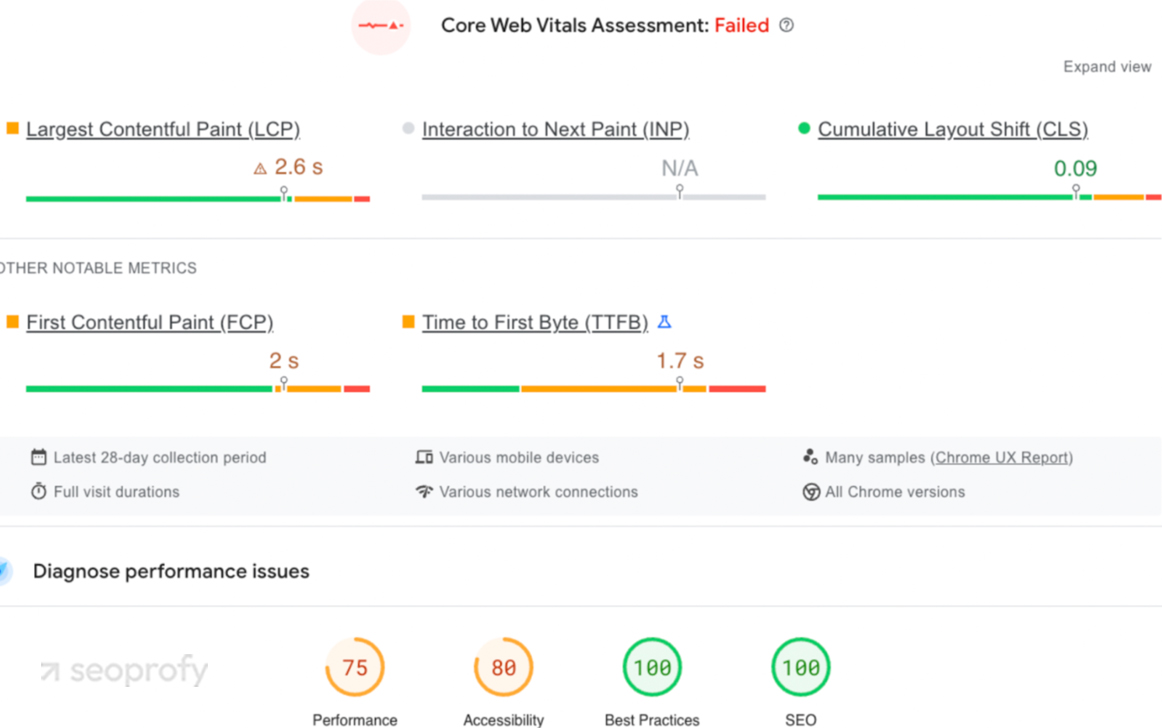
All of this is just the surface. SEO includes many moving parts. This is why many profitable businesses choose to delegate it to a law firm SEO agency with proven experience.
Use Paid Channels to Speed Up Reach
PPC can be a smart move early on, especially when your business has no brand recognition or SEO traction yet. It helps bring in more clients quickly, while other strategies for law firm growth are still building up. That said, PPC isn’t always cost-effective in the long run. In fact, while PPC can deliver quick visibility, 97% of legal professionals say it’s too costly to maintain a strong ROI. In contrast, the ROI of SEO is seen as more sustainable and better suited for long-term growth.
Let’s run a quick example. The top bid for “divorce lawyer” is about $32.67 per click. If we assume your campaign is well-optimized and converting at around 3%, you might need roughly 33 clicks to generate a single lead. That puts the estimated cost per lead near $1,080. And that’s just a lead, not a signed client.
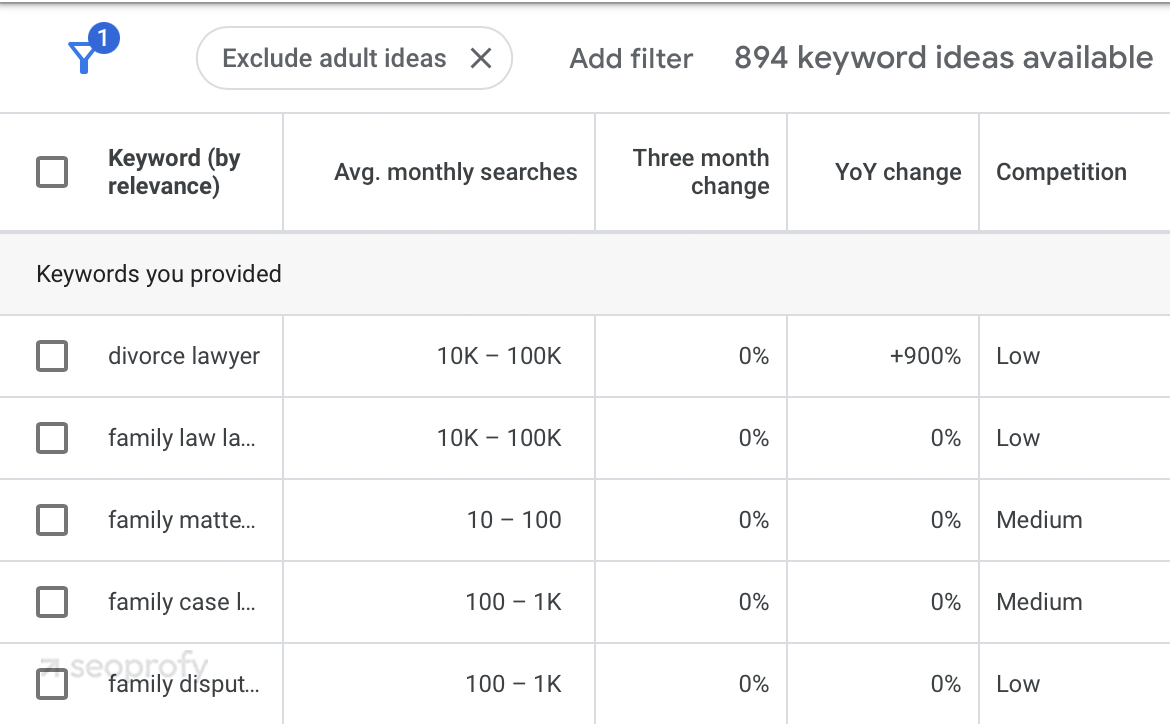
This doesn’t mean PPC doesn’t work. It means it works best when tightly managed, paired with great landing pages, and used strategically. Some firms experiment with pay for performance SEO, but this model carries risks — such as black-hat tactics — if not managed by trusted professionals.
Stay Present on the Right Platforms
Your law firm’s website is the foundation, but not the full picture. Keep up-to-date profiles on directories like Avvo, Justia, and your Google Business Profile. Fill in legal services, monitor reviews, and respond consistently.
For social media, choose one or two platforms where your target audience actually spends time. More than 70% of lawyers say they’ve attracted new leads through social media. So, a few meaningful updates each month (company news, case wins, community work) can often do more than a daily stream of filler content on blogs.
We turn your website into a consistent source of high-quality leads from organic search:
- Content that matches client intent
- SEO that supports every practice area
- Placement in local and national listings
- Results that keep compounding over time

6. Measure and Refine Your Growth Strategies
Tracking allows you to understand which marketing efforts bring ideal clients, which parts of your intake process lose them, and how profitable each practice area is. Without that data, you cannot allocate budget effectively, spot performance issues, or grow your law firm successfully.
Start by tracking general marketing and SEO performance. Focus on metrics like:
- Cost per lead (CPL)
- Conversion rate by channel
- Marketing-qualified leads (MQLs) per practice area
Use platforms such as Google Analytics 4, HubSpot, or CallRail to monitor lead sources and behavior. Paid channels like Google Ads should be evaluated based on return on ad spend (ROAS) and cost per signed client, not just click volume. For reference, the average ROI for PPC in the legal industry is around 2.2%.
Next, evaluate intake and conversion. Track how many leads convert into consultations, how many consultations become retained clients, and where drop-offs occur. Tools like Lawmatics, Clio Grow, or Lead Docket help automate this process. Your intake workflow should have clearly defined steps. Review these weekly:
- Time to first response
- Consultation show-up rate
- Close rate after consultation
Client loyalty, including repeat business and satisfaction, is just as critical as lead generation for lawyers. Track repeat business, client churn, and referral volume. Use follow-up surveys to gather Net Promoter Score (NPS) and satisfaction at different points in the engagement. This feedback shows what is working and where expectations are not being met.
On the financial side, monitor:
- Client acquisition cost (CAC)
- Average case value
- Lifetime client value (LCV)
- Profit margin per practice area
- Revenue per attorney
Compare these across time periods, practice areas, and law firm marketing channels. If CAC increases but client value stays flat, revisit targeting and intake quality. Also, look closely at SEO service costs for a law firm. Expensive campaigns that don’t attract clients can quietly drain profit margins. If profit margins are shrinking despite revenue growth, check operational costs. These financial indicators help prioritize what to scale, cut, or fix before investing more.
Build a monthly review process that includes both marketing and financial metrics. Involve key team members, measure success, identify underperforming areas, and document next steps.
Start Your Growth Journey Today
The legal industry is a battleground of attention and trust. Winning online is hard, especially when you’re also the one running the company, managing the team, and handling every urgent fire. No one teaches you how to grow a successful law firm. You’re expected to figure it out as you go.
You don’t have to. At SeoProfy, we’ve walked this path with dozens of law firms. We know how to get you found, how to make people reach out, and how to avoid the traps that slow most new businesses down. Whatever your SEO objectives are (build credibility, get more visibility, high-quality leads, or have better positioning), we’ve handled them before and know what marketing tactics work. Check out our SEO case studies to see what’s possible when execution meets experience.













